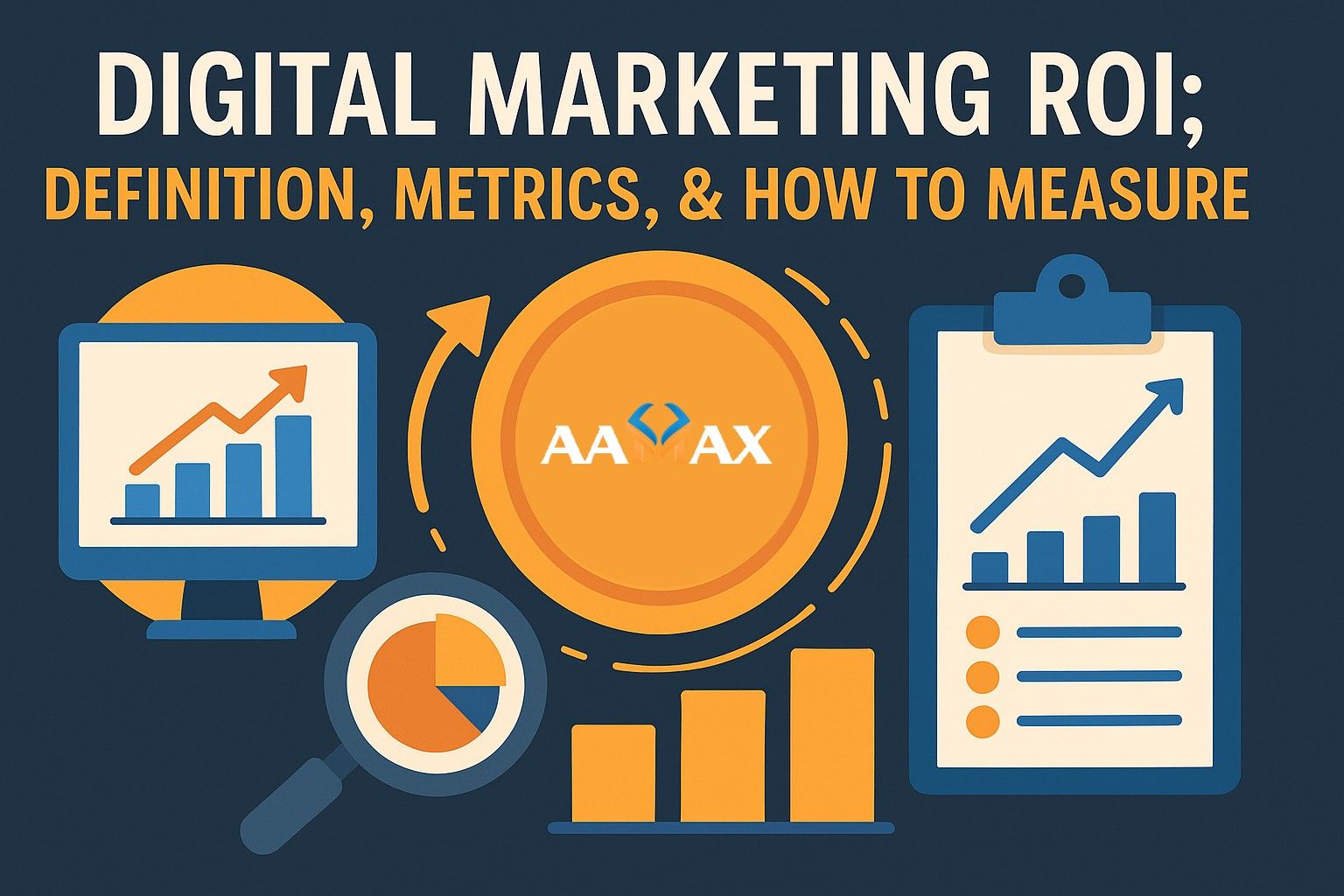
Digital Marketing ROI: Definition, Metrics, & How to Measure
Understanding Digital Marketing ROI (Return on Investment) is essential for businesses aiming to maximize the effectiveness of their online strategies. In a landscape where marketing budgets are carefully scrutinized, proving that your digital efforts generate measurable results is no longer optional—it's a necessity.
This comprehensive guide will help you understand what digital marketing agency ROI is, why it matters, the key metrics to track, and practical methods to measure and improve it.
If you want expert help in building campaigns that deliver a measurable ROI, you can hire AAMAX, a full-service digital marketing company offering Web Development, Digital Marketing, and SEO services.
What is Digital Marketing ROI?
Digital Marketing ROI measures the revenue generated from your digital marketing activities against the costs of running those activities. In simple terms, it answers:
“For every dollar spent on digital marketing, how much revenue did I earn?”
The formula for calculating Digital Marketing ROI is:
ROI (%) = [(Revenue from Digital Marketing - Cost of Digital Marketing) / Cost of Digital Marketing] x 100
For example, if you spent $2,000 on a Google Ads campaign that generated $8,000 in sales, your ROI would be:
[(8,000 - 2,000) / 2,000] x 100 = 300%
This means you earned $4 for every $1 spent on your campaign.
Why Measuring Digital Marketing ROI Matters
Many businesses invest heavily in digital marketing without a clear understanding of its return, resulting in wasted budgets and missed opportunities for scaling successful strategies. Measuring ROI allows you to:
- Justify digital marketing budgets to stakeholders.
- Identify which channels and campaigns perform best.
- Optimize underperforming strategies based on data.
- Align marketing goals with overall business objectives.
- Make informed decisions for future campaigns.
Without measuring ROI, you cannot confidently determine if your digital marketing is helping your business grow or draining resources.
Key Metrics That Impact Digital Marketing ROI
While ROI is a straightforward formula, several supporting metrics help you understand what contributes to your ROI and where to optimize:
1. Customer Acquisition Cost (CAC)
CAC is the average cost of acquiring a new customer. It is calculated as:
CAC = Total Marketing Costs / Number of Customers Acquired
Lower CAC means higher ROI, assuming consistent revenue.
2. Customer Lifetime Value (CLV or LTV)
CLV measures the total revenue a customer generates during their relationship with your business. It helps you understand how much you can invest in acquiring customers while maintaining profitability.
3. Conversion Rate
This measures the percentage of visitors who complete a desired action, such as filling out a form or making a purchase. Higher conversion rates typically lead to better ROI.
4. Cost Per Lead (CPL)
CPL helps you understand how much you pay to generate a lead. If CPL is high and leads are low-quality, your ROI will suffer.
5. Click-Through Rate (CTR)
CTR measures how often people click on your ads or emails. A higher CTR often indicates that your messaging resonates with your audience.
6. Revenue Attribution
Revenue attribution connects sales to specific campaigns or channels, helping you understand which efforts generate the most revenue.
7. Return on Ad Spend (ROAS)
ROAS is specifically used for paid advertising:
ROAS = Revenue from Ads / Cost of Ads
While similar to ROI, ROAS does not subtract other operational costs and is used to measure ad-specific performance.
Channels to Track for Digital Marketing ROI
Your digital marketing efforts likely span multiple channels, each requiring ROI measurement:
- Pay-Per-Click (PPC) Advertising: Google Ads, Bing Ads
- Social Media Marketing: Facebook, Instagram, LinkedIn, TikTok
- Content Marketing: Blogs, case studies, white papers
- Email Marketing: Campaigns and newsletters
- SEO (Search Engine Optimization): Organic traffic efforts
- Affiliate Marketing: Partnerships and influencer campaigns
Tracking ROI across these channels helps you identify where your marketing dollars generate the highest returns.
How to Measure Digital Marketing ROI Effectively
Measuring ROI requires a systematic approach, clear goal-setting, and proper tracking mechanisms.
1. Define Clear Goals
Before launching any campaign, define your objectives:
- Increase website traffic
- Generate leads
- Drive sales
- Improve customer retention
Clear goals will guide your measurement and reporting processes.
2. Set Up Tracking and Analytics
Use tools like Google Analytics, Google Tag Manager, and CRM systems to track user behavior, conversions, and revenue generation accurately.
3. Track All Relevant Costs
Include:
- Ad spend
- Agency fees
- Content creation costs
- Tools and software
- Staff salaries (proportionate to marketing efforts)
Many businesses underreport costs, leading to inaccurate ROI calculations.
4. Attribute Revenue Correctly
Revenue attribution can be:
- First-touch: Credits the first interaction channel.
- Last-touch: Credits the final interaction before conversion.
- Multi-touch: Distributes credit across all touchpoints in the customer journey.
Multi-touch attribution provides a holistic view of which channels contribute most to your ROI.
5. Calculate ROI Regularly
Perform monthly, quarterly, and campaign-based ROI calculations to understand trends, seasonality, and the long-term performance of your digital marketing efforts.
Challenges in Measuring Digital Marketing ROI
1. Long Sales Cycles
For businesses with extended sales cycles, attributing revenue to a specific campaign can be complex.
2. Multi-Touch Customer Journeys
Customers often interact with multiple channels before converting, making attribution challenging.
3. Data Fragmentation
Using different tools and platforms without integration leads to incomplete data, affecting measurement accuracy.
4. Non-Revenue Goals
If your campaign focuses on brand awareness rather than direct sales, calculating ROI becomes less straightforward. In such cases, consider using engagement metrics as proxies.
Strategies to Improve Your Digital Marketing ROI
1. Focus on High-Performing Channels
Identify and double down on the channels that consistently generate the highest ROI.
2. Optimize Conversion Rates
Small improvements in conversion rates can significantly boost your ROI. Use A/B testing on landing pages, CTAs, and ad creatives.
3. Leverage Retargeting
Retarget website visitors who did not convert to increase the chances of closing sales without significant additional costs.
4. Personalize Customer Journeys
Use segmentation and personalized messaging to improve engagement and conversion rates.
5. Automate Where Possible
Marketing automation can improve efficiency, reduce costs, and allow your team to focus on strategy and creative efforts.
6. Invest in Content Marketing
Evergreen content continues to drive traffic and leads over time, reducing customer acquisition costs.
7. Analyze and Iterate
Continuous analysis of your campaigns and applying insights will help you optimize your marketing strategies for maximum ROI.
Tools for Measuring Digital Marketing ROI
Several tools can help you track and optimize your ROI:
- Google Analytics: For tracking traffic and conversions.
- HubSpot: For integrated marketing and sales ROI tracking.
- SEMrush: For SEO and PPC performance measurement.
- Google Data Studio: For creating custom dashboards.
- CRM Systems (Salesforce, Zoho): For revenue attribution and customer lifecycle tracking.
The Future of Digital Marketing ROI Measurement
As technology evolves, measuring ROI will become more precise with:
- AI-driven analytics: To predict campaign outcomes.
- Advanced attribution models: For better understanding of customer journeys.
- Integrated dashboards: That consolidate data from all platforms.
- Privacy-centric measurement: As cookie tracking diminishes, first-party data strategies will become essential.
Businesses that adapt to these changes will be better positioned to measure, understand, and improve their digital marketing ROI.
Final Thoughts
Measuring Digital Marketing ROI is crucial for understanding the effectiveness of your marketing spend, optimizing campaigns, and scaling your business profitably. It requires:
✅ Clear goal-setting
✅ Accurate tracking
✅ Understanding of key metrics
✅ Data-driven decision-making
If you want to ensure your digital marketing budget is delivering measurable returns while scaling your online presence, consider partnering with experts. AAMAX offers comprehensive digital marketing, web development, and SEO services designed to help businesses track, measure, and improve their ROI efficiently.
By applying the principles and strategies outlined in this guide, you will be equipped to transform your digital marketing into a predictable, revenue-generating engine for your business.







